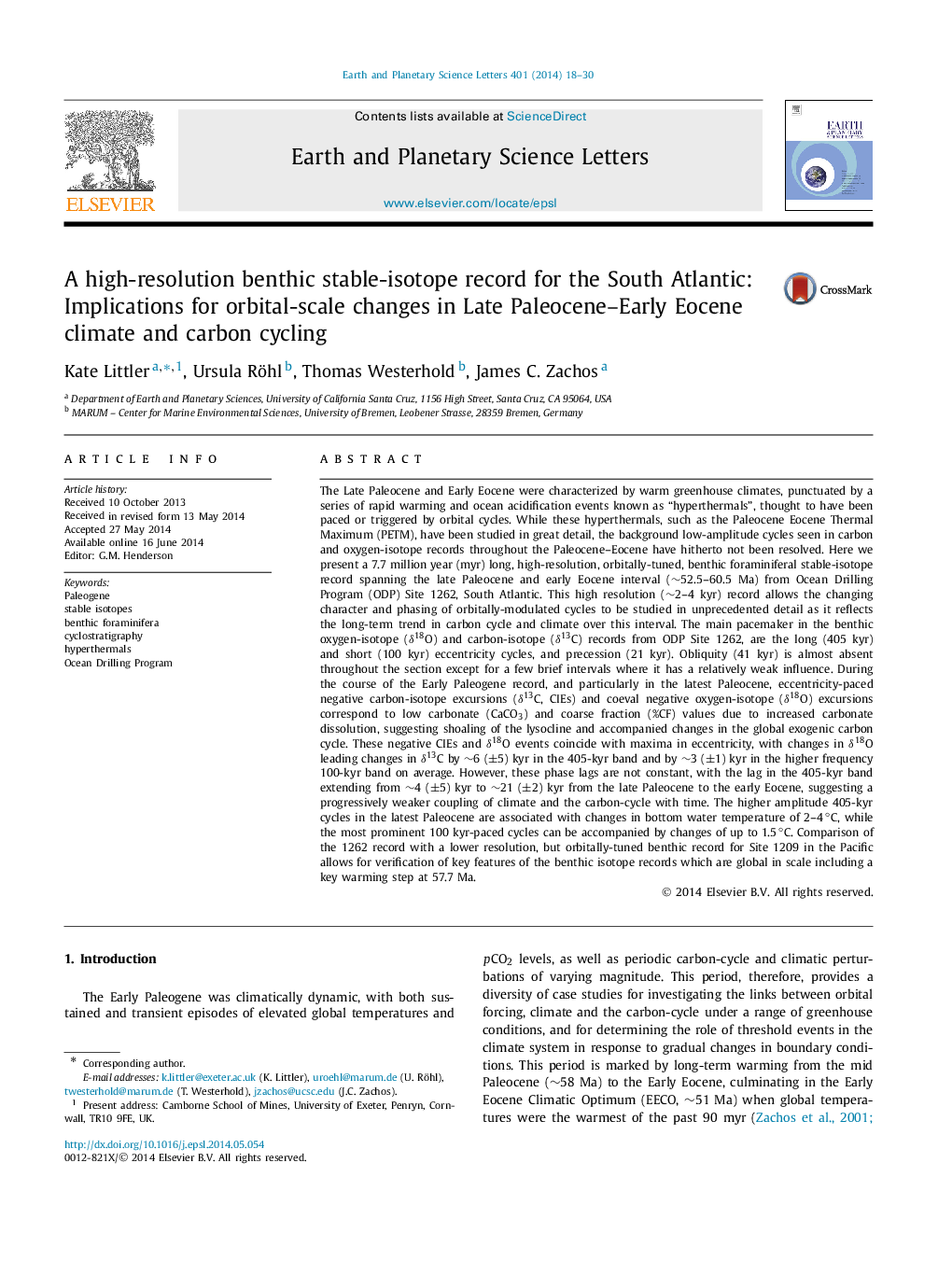| کد مقاله | کد نشریه | سال انتشار | مقاله انگلیسی | نسخه تمام متن |
|---|---|---|---|---|
| 6429173 | 1634755 | 2014 | 13 صفحه PDF | دانلود رایگان |
• A 7.7-myr long, orbitally-tuned, benthic stable-isotope record is presented.
• Site 1262 data is the longest complete Atlantic record for the Paleocene–Eocene.
• Long and short eccentricity and precession are the dominant pacemakers.
• Consistent low power in the obliquity band suggests small polar ice volumes.
• Sedimentary carbon reservoirs may include permafrost, peat, or methane hydrate.
The Late Paleocene and Early Eocene were characterized by warm greenhouse climates, punctuated by a series of rapid warming and ocean acidification events known as “hyperthermals”, thought to have been paced or triggered by orbital cycles. While these hyperthermals, such as the Paleocene Eocene Thermal Maximum (PETM), have been studied in great detail, the background low-amplitude cycles seen in carbon and oxygen-isotope records throughout the Paleocene–Eocene have hitherto not been resolved. Here we present a 7.7 million year (myr) long, high-resolution, orbitally-tuned, benthic foraminiferal stable-isotope record spanning the late Paleocene and early Eocene interval (∼52.5–60.5 Ma) from Ocean Drilling Program (ODP) Site 1262, South Atlantic. This high resolution (∼2–4 kyr) record allows the changing character and phasing of orbitally-modulated cycles to be studied in unprecedented detail as it reflects the long-term trend in carbon cycle and climate over this interval. The main pacemaker in the benthic oxygen-isotope (δ18O) and carbon-isotope (δ13C) records from ODP Site 1262, are the long (405 kyr) and short (100 kyr) eccentricity cycles, and precession (21 kyr). Obliquity (41 kyr) is almost absent throughout the section except for a few brief intervals where it has a relatively weak influence. During the course of the Early Paleogene record, and particularly in the latest Paleocene, eccentricity-paced negative carbon-isotope excursions (δ13C, CIEs) and coeval negative oxygen-isotope (δ18O) excursions correspond to low carbonate (CaCO3) and coarse fraction (%CF) values due to increased carbonate dissolution, suggesting shoaling of the lysocline and accompanied changes in the global exogenic carbon cycle. These negative CIEs and δ18O events coincide with maxima in eccentricity, with changes in δ18O leading changes in δ13C by ∼6 (±5) kyr in the 405-kyr band and by ∼3 (±1) kyr in the higher frequency 100-kyr band on average. However, these phase lags are not constant, with the lag in the 405-kyr band extending from ∼4 (±5) kyr to ∼21 (±2) kyr from the late Paleocene to the early Eocene, suggesting a progressively weaker coupling of climate and the carbon-cycle with time. The higher amplitude 405-kyr cycles in the latest Paleocene are associated with changes in bottom water temperature of 2–4 °C, while the most prominent 100 kyr-paced cycles can be accompanied by changes of up to 1.5 °C. Comparison of the 1262 record with a lower resolution, but orbitally-tuned benthic record for Site 1209 in the Pacific allows for verification of key features of the benthic isotope records which are global in scale including a key warming step at 57.7 Ma.
Journal: Earth and Planetary Science Letters - Volume 401, 1 September 2014, Pages 18–30
